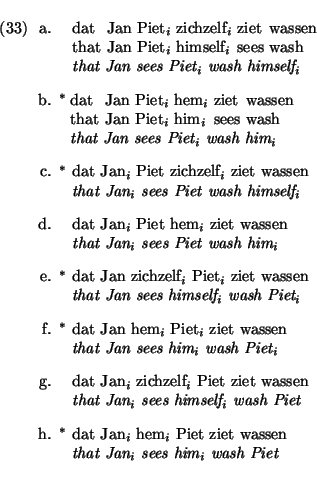
In these examples, the impossibility of (33h) illustrates a clause-union effect:

Let us attempt to analyse the sentences above solely in terms of SUBCAT. Since we are assuming that non-finite verbs do not contain a subject on their SUBCAT list, such an account is utterly impossible. However, we will illustrate that problems remain, even if we tentatively assume that subjects are present on the subcat list of non-finite verbs.
In (33a-d) there are two relevant SUBCAT lists: the
matrix one essentially is a list containing three noun phrases, the
most oblique one being the anaphor:
![]() Jan, Piet, pro
Jan, Piet, pro![]() ; and the embedded one which is similar
except that the (matrix) subject is not there:
; and the embedded one which is similar
except that the (matrix) subject is not there:
![]() Piet, pro
Piet, pro![]() .
.
(33a) is predicted to be grammatical: principle A is satisfied (in both lists). (33b) is ruled out, because principle B is violated (in both lists). In order to properly rule out (33c) we must assume that principle A holds universally because only in the embedded SUBCAT list principle A is violated. In (33d) we must assume that principle B applies in an existential way: in the embedded SUBCAT list the pronoun is locally free.
In (33e-h) the two SUBCAT lists are
![]() Jan, pro, Piet
Jan, pro, Piet![]() and
and
![]() pro, Piet
pro, Piet![]() , respectively.
(33e) and (33f) are ungrammatical (principle C
violation). (33g) is allowed in both a universal and
existential interpretation of the binding constraints. Finally
(33h) can only be ruled out under a universal
interpretation of principle B.
, respectively.
(33e) and (33f) are ungrammatical (principle C
violation). (33g) is allowed in both a universal and
existential interpretation of the binding constraints. Finally
(33h) can only be ruled out under a universal
interpretation of principle B.
Thus we have constructed a paradox concerning principle B. (33d) requires an existential interpretation of principle B, but (33h) requires a universal interpretation. Note that principle A requires a universal interpretation.